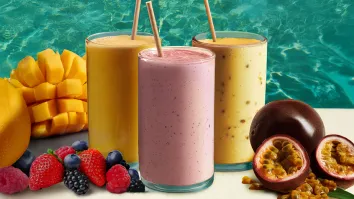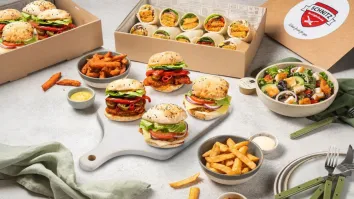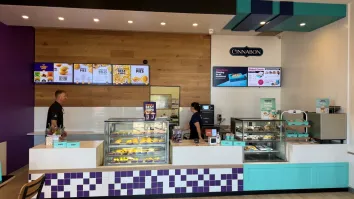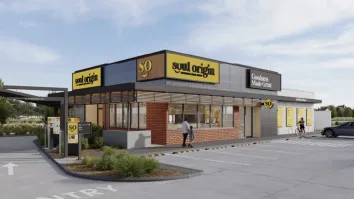QSRs wield new technologies to win the digital ordering war
The great digital ordering war is brewing – at least that’s what QSR executives and trend forecasters are predicting as foodservice digital ordering reached 117 million visits and $1.2b last year.
Winning this war will be crucial for QSR brands that want to dominate in the coming decades, and part of this requires leveraging on new technologies such as geolocation and robotic units. An ability to forge technology partnerships will also be key source of competitive advantage for QSR brands.
These insights on the power of technology in driving digital ordering was discussed during a recent Oracle Hospitality Roundtable on the digital transformation happening in foodservice. Looking to create forums that will spark senior-level dialogue and engagement, Oracle invited representatives from QSR brands such as La Porchetta, Lennard's Chicken, Nando's, Grill'd Healthy Burgers, Town & Country Pizza, Ferguson Plarre Bakehouses, Bubba Pizza, PappaRich, PCG Consultancy, The Sporting Globe, Caltex / Nashi, Fonda, Lord of the Fries, and Love Pollo.
Geolocation
Among the emerging technology trends, QSRs should look into geolocation, or the identification or estimation of the real-world geographic location of a consumer using a digital device such as a mobile phone or an Internet-connected computer terminal, says Ciara Clancy, director of Australian foodservice at The NPD Group, which presented the findings of the company’s “Digital Transformation in Foodservice” report during the roundtable discussion.
“When you go to TripAdvisor it can pop up to recommend a restaurant. You’ll see a lot more brands using that,” says Clancy on the power of geolocation in capturing the attention of digital consumers that are open to knowing the available nearby options to them. “Food is a food porn business now, it’s a pastime in itself.”
Clancy reckons that it can be intimidating for smaller brands to dive into geolocation and compete with the big boys on digital platforms, but she argues that it is the best time for smaller brands to start flexing their muscles.
“Ultimately, it’s created a level playing field not just for independents, but for smaller brands,” says Clancy. “Size does not matter in this situation, it’s literally how you do it is the winning factor.”
She advises brands to focus on choosing the right digital platforms to be in and use their resources to deliver perfect execution. Digital consumers are bombarded with choices, so they will appreciate brands that make the extra effort to connect with them – and it is not necessarily the brand that throws the most money at the situation that consumers will choose.
“People are empowered. They are going to spend thirty minutes educating themselves before making that choice,” says Clancy.
Robotics
Another emerging technology trend is the use of robotics. Domino’s recently tapped into robotics and launched the Domino’s Robotic Unit (DRU), an autonomous delivery vehicle that looks to revolutionise how pizza is delivered. The DRU determines the best path of travel and is guided to his destination using on-board sensors.
Clancy reckons the DRU promises reduced delivery times and manpower costs, and represents an exciting competitive advantage since speed of delivery is a major consideration for many digital consumers. “DRU has become a big thing for them,” she says.
While it should be some time before Australians will see an army of DRUs running around the streets and delivering pizzas to their homes, brands should start thinking about the potential of robotics to change the game, especially when it comes to delivery.
Drive thru and delivery has long been a contentious area, and robotics and other technology trends such as artificial intelligence and automation could tip the scale on the side of delivery. Clancy points out that in the US, delivery has completely rolled over the drive thru business, with delivery growing fast in the past few years while drive thru traffic has plummeted.
“What you’re going to find is that even though drive thru had one of the best years on record, and dealing better than delivery, the drive thru market is going to be challenged,” she says. “The thing that delivery have to get right is accessibility and delivery times, once those two things are addressed, that’s when drive thru will get under pressure from this.”
Even more exciting, robotics promises to turn the art of food service into efficient manufacturing in the near future, according to Oracle Hospitality 2025 Restaurant report.
The more than 250 restaurant operators surveyed by the report predicted that by 2025, robotics will start to be used for kitchen prep, quality checking in the kitchen, staff training, and serving and seating guests - that is on top of the robot cleaning, which almost half predict to be a mainstream occurrence in eight years.
The report cited Suzumo International in Japan, which has developed sushi robots capable of creating 3,600 pieces of nigiri per hour, or a complete sushi roll every 12 seconds. This turns a typically labor-intensive food dish into a viable option for sports stadiums and arenas, schools and other mass-audience venues.
Similarly, Middleby Corp., a kitchen equipment maker, and Rethink Robotics debuted a robotic employee that could make a batch of French fries as fast as a line cook. The company has said the $30,000 robot can spend 35,500 hours of repeatable cooking for five years.
“Robotics already has had a profound impact on the automotive and healthcare industries. It seems destined to reshape restaurants, too,” the report said, citing a National Robotics Education Foundation study which revealed a typical QSR location could reallocate 1.2 workers from counter service with the adoption of robots to do remote order taking and other tasks. In the U.S. alone, this labor shift could translate to more than $12 billion in wage savings.
“Add evidence proving robots are more accurate and more successful at upselling (and won’t complain about dull, repetitive tasks such as cleaning), and it is clear they will play a vital role in restaurants,” the report added.
With robotics looking to increase accessibility, improve delivery times and even deliver billions in savings from more efficient operations, QSR brands must also start planning.
Tech partnerships
Speaking of planning ahead, it can be overwhelming for even the biggest QSR brands to anticipate each new technology in the foodservice space. This is where tech partnerships can play a huge role – and is a strategy that big brands like Domino’s are adopting.
“It’s not that they don’t know what they’re doing in technology, but they are investing in partnerships to help them along the way. And it is something that brands should look at to do that,” says Clancy.
Partnerships make it much easier for QSR brands to take advantage of new technology without having to go through costly training, slow implementation, and steep investments. Basically, risk is reduced as QSR brands can stick to their core business while their tech partners bring in honed processes and expertise.
One notable area of strong partnership is when it comes to QSR brands joining third-party aggregators in pursuit of greater reach among digital consumers. In fact, two of the leading third-party aggregators have shown double-digit growth in number of restaurants registered from 2015 to 2016: Menulog rose roughly 27% to more than 7,000 in that period, while Foodora rose roughly 50% to more than 3,000. But one industry executive warns that a wrong partnership can hurt the brand more than it helps.
“It’s funny when we talk about premium restaurants, and they’re trying to climb into the digital space, and they’re using these other platforms to increase delivery and percentages in the businesses,” but he warns that in some cases, these same premium restaurants do not consider the “delivery driver in the shoddy car, in raggedy clothes, delivering your product. That’s the last touch point of your customer.”
Powerful point-of-sale (POS) systems
When searching for game-changing technology, QSRs should not overlook the ubiquitous POS systems in their restaurants, which can be made more powerful to provide competitive advantages.
The first competitive advantage can be unlocked when QSRs integrate their POS systems to food aggregators, which started to pop up in 2000s, said Grahame Tate, Vice President Hotels and F&B, JAPAC Oracle Hospitality. This quickens the processing of online and mobile orders, often empowering the restaurants to complete faster deliveries.
The smoother and quicker transactions leave a positive impression on online customers, and makes QSRs with integrated POS systems a preferred choice in a portal that can contain hundreds of other brands. In the same vein, POS systems can also be integrated to new economy delivery solutions such as UberEats and GetSwift, cutting delivery times and generating data insights on online customer habits.
Lastly, Tate explains that powerful POS systems, like those designed by Oracle Hospitality, provide data protection and agility that are critical in a digital, Millennial-driven market. “Ensuring POS is a platform that is secure and, most importantly, scalable as demand will fluctuate” will be a key consideration for QSRs in the coming years, he says.























